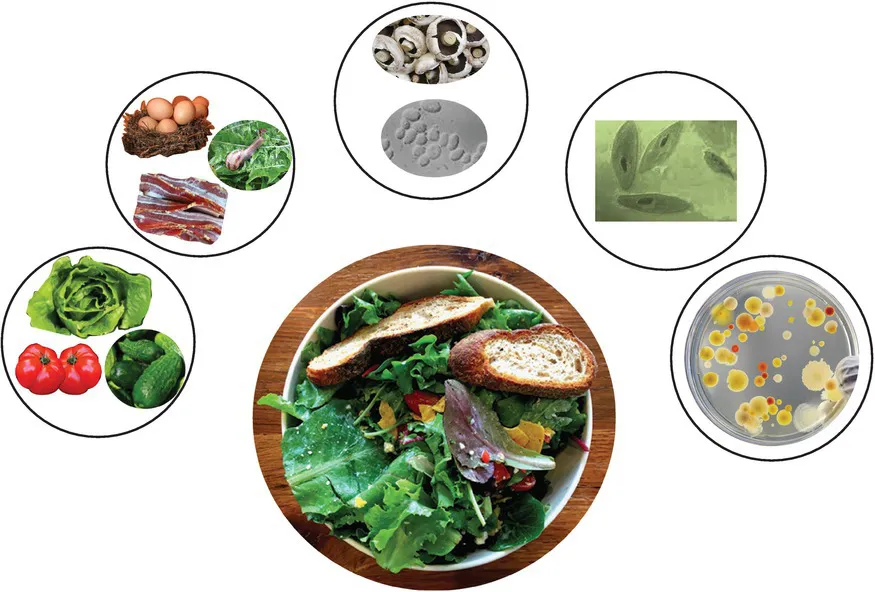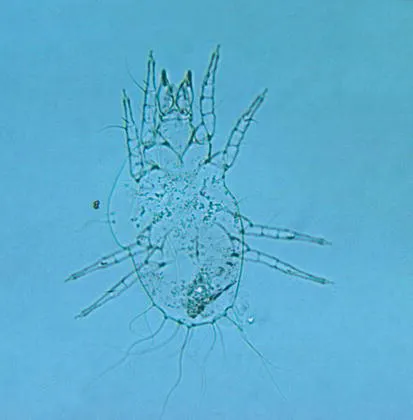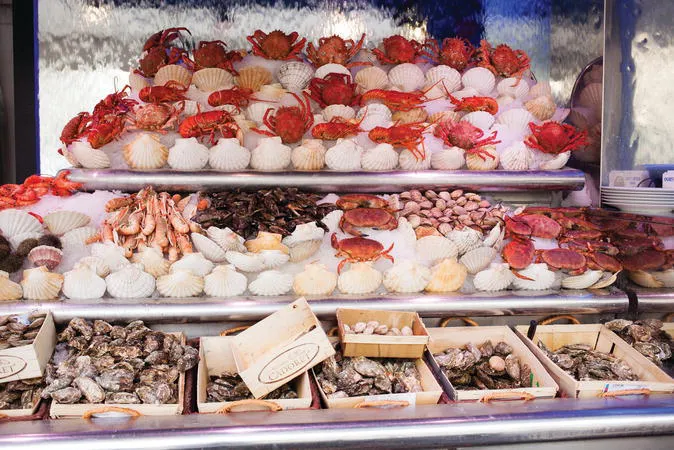![]()
1 Food
Key questions
• What are some of the major food groups consumed globally?
• What are some examples of unusual or exotic foods?
• What are food supply networks?
In the field of food safety, common terminology used includes risk and risk management to prevent foodborne illnesses caused by microbial, chemical, or physical hazards. This chapter will focus on the complexity that is food and introduce concepts for how microorganisms can become problems or risks in foods. It will also introduce thinking about how humans manage the food supply to lower the risk of foodborne illness caused by microorganisms.
Review of Biological Kingdoms and Who is Eating Whom
To understand food systems, one should first thoroughly understand food. Everyone thinks they understand food, since we have been eating our entire lives. You are familiar with the foods that you purchase, and perhaps even grow in your own garden. You may even understand how food is produced and processed. Let’s take some time to review what food is in the biological sense.
Food, as defined by the Oxford English Dictionary, is “Any nutritious substance that people or animals eat or drink in order to maintain life and growth; nourishment, provisions.” Basically, food is a source of energy and structural maintenance in living organisms. Any living organism can be a potential food source to other living organisms, humans included.
When we think about living organisms and food, we start thinking about plants and animals and the food substances they provide. But, think further. Do we just consume plants and animals? Do you like mushrooms? When you eat a fresh salad, is it just plants?
For the purpose of our discussion, let’s consider the five biological kingdoms: Animalia (animals), Plantae (plants), Fungi (yeasts, molds and mushrooms), Protista (protozoa), and Eubacteria (bacteria of importance in food). Also, keep in mind that biological organisms live in complex biological communities or ecosystems where it is very common to find multiple kingdoms represented. Most organisms used as food sources are not just that organism, but also the ecosystem they carry with them, most of which is microscopic. This microscopic environment is known as the microbiome.
In that fresh salad, there may be several kingdoms represented in its unique ecosystem (Fig. 1.1). In addition to all of these life forms, there may also be viruses (tiny nucleic acid-based organisms that are dependent on host cells for biological activity), which may be contaminants or infecting the other organisms or tissues in the bowl (Forterre, 2010). Once a human consumes the salad, some of the intact and viable microscopic organisms could remain and colonize the intestinal tract, and use the human host for food. This host utilization may harm (pathogenic/parasitism), benefit (probiotic/mutualism), or make no significant difference (commensalism) to the host. Who is eating whom?
An old joke:
Q: What is worse than finding a worm in an apple?
A: Finding only half a worm!
Table 1.1 Biological kingdoms represented as tissues or intact in a fresh salad. See Fig. 1.1 for visual details.
| Biological kingdom | Parts of the salad |
| Plants | Lettuce and any other fruits, vegetables, tofu, seeds, oils, and nuts |
| Animals | Meat, cheese, eggs, insects, mites (see Fig. 1.2), and worms |
| Fungi | Mushrooms, molds, and yeasts |
| Protozoa | Various harmless protozoa and possibly some parasites |
| Bacteria | Natural microflora of ingredients and possible pathogenic contaminants |
Typically, the more processed a human food is, the less living microscopic biological diversity is represented, but there may also be less nutrition. Only a few rare food items would be completely sterile and void of microscopic life. Foods considered commercially sterile and shelf stable can still harbor viable microbial spores. These are aspects of our food supply that are important to consider in complex food networks and in microbial food safety.
Let’s explore some more about the main types of foods consumed by humans around the world to ensure we are thoroughly considering food systems. Kearney (2010) categorizes foods evaluated for global consumption trends into these categories:
• cereals;
• meat;
• eggs, milk, and other dairy products;
• fish;
• vegetables; and
• energy providers: vegetable oils, animal fats, and sugar.
The next few sections will relate to these terms for global consumption rates, but are categorized differently to stick to our biological contexts.
Animal-Based Foods
There is a wide array of animals that have supplied food for humans since the dawn of man. Many diseases of animals can be transmitted to humans through animal husbandry or food transmission. Zoonotic diseases are infectious diseases that are transmitted between vertebrate animals and humans (see Box 1.1).
Box 1.1. An example of Salmonella as a cause of zoonotic disease
Salmonella are bacteria that can be found in many animal species from arthropods to large mammals. Not all cause disease in animals, and often animals, including humans, are carriers. There are many strains of Salmonella, and Chapter 7 will go into more detail about these. Of these many strains, the ones that have been linked to animal infection have often been directly correlated to specific animal species, and are considered host adapted. However, several of these host-adapted strains can also cause illness in humans. When these strains are transmitted from animal to human, or vice versa, that is considered a zoonosis.
Salmonella is most commonly transferred through the fecal–oral route, although eggs and milk also serve as sources of disease-causing Salmonella. The bacteria are able to colonize the internal portion of the egg as it develops in the ovary of an infected animal or the milk-secreting tissues of an infected mammal. When a human consumes an undercooked egg, non-pasteurized milk, or fecal-contaminated food, salmonellosis can be the result. According to Forshell and Wierup (2006) “Salmonellosis is the most common food-borne bacterial disease in the world”.
Terrestrial mammals and birds
Animals, including mammals and birds that walk the land, have always been common sources of food for humans. Globally, the most common mammals eaten for meat by humans are goats, followed by sheep, pigs, and cattle; the most common birds are chickens (Kearney, 2010) (Fig. 1.3).
For a disturbing yet fascinating perspective on human culture and the history of animal use for food, readers are encouraged to read Near a Thousand Tables by Fernandez-Armesto (2002). This book includes a chapter describing cannibalism, and explains aspects of survival, culture, and aggression. This quote is used to start that chapter:
Cannibalism is a problem. In many cases the practice is rooted in ritual and superstition rather than gastronomy, but not always. A French Dominican in the seventeenth century observed that the Caribs had most decided notions of the relative merits of their enemies. As one would expect, the French were delicious, by far the best. This is no surprise, even allowing for nationalism. The English came next, I’m glad to say. The Dutch were dull and stodgy and the Spaniards so stringy they were hardly a meal at all, even boiled. All this sounds sadly like gluttony.
Patrick Leigh Fermor
Freshwater and seafood animals
The biological diversity within this category of animal foods is vast, and includes vertebrates and invertebrates. Global consumption trends include mainly white fish, oily fish, and seafood invertebrates (Kearney, 2010) (Fig. 1.4).
Insects, annelids, and reptiles
Data are lacking for global consumption rates of these animals. However, in certain parts of the world, these can provide a critical source of protein.
“Approximately 1,900 insect species are eaten worldwide, mainly in developing countries” (van Huis, 2013). The potential for insects as mini-livestock to mitigate environmental impact and food sustainability has been reviewed by van Huis (2013). Likely candidates include yellow mealworm, the house cricket, and the migratory locust. The Food and Agriculture Organization of the United Nations encourages insect consumption as part of a strategy to ensure an adequate world food supply, and state:
Insects as food and feed emerge as an especially relevant issue in the twenty-first century due to the rising cost of animal protein, food and feed insecurity, environmental pressures, population growth and increasing demand for protein among the middle classes. Thus, alternative solutions to conventional livestock and feed sources urgently need to be found. The consumption of insects, or entomophagy, therefore contr...




